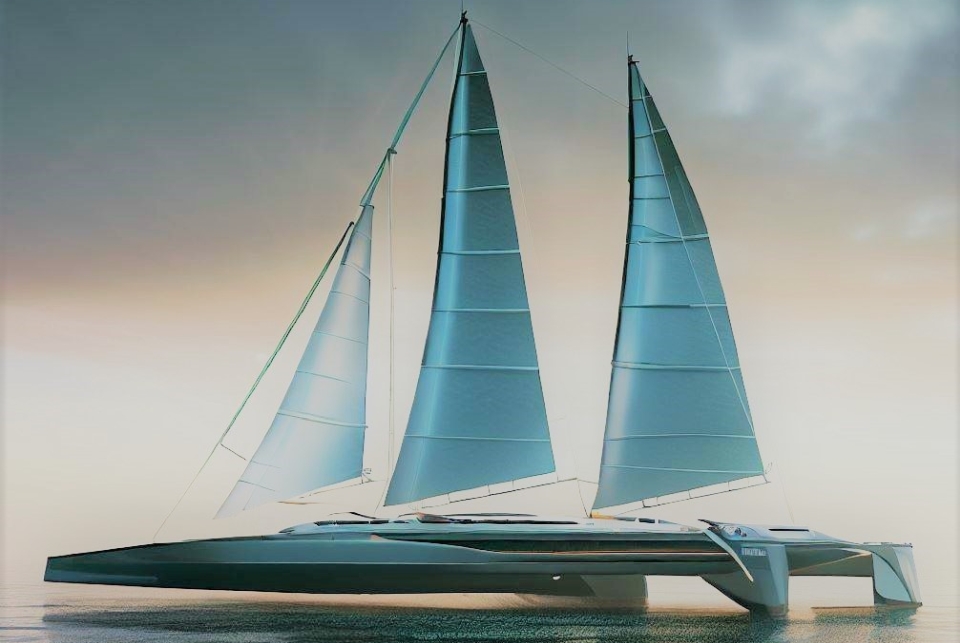In an ever-evolving world where technological advancements are transforming industries at an unprecedented pace, the maritime yachting industry is also experiencing a remarkable transformation. Amidst this wave of innovation, the integration of artificial intelligence (AI) has emerged as a game-changer, revolutionising how ships and yachts are designed and engineered.

This article was published in SWZ|Maritime’s September 2023 yacht special. It was written by Kirsten Odendaal, project manager within the yacht team at MARIN and enthusiast of machine learning and its applications within the maritime industry, k.odendaal@marin.nl.
By leveraging AI’s immense capabilities, naval architects and engineers can now access powerful tools that enhance their understanding of ship behaviour and optimise the design process.
Traditionally, the industry relied on physics-based modelling to comprehend ship and yacht building system behaviour. However, these models often sacrificed prediction accuracy for the sake of generalisation and computational efficiency. This compromise limited the industry’s ability to achieve optimal design outcomes.
Fortunately, with the introduction of machine learning, engineers can now harness the potential of extensive datasets to uncover complex patterns and establish previously unattainable connections. By incorporating real-world operational data, machine learning models significantly improve accuracy and capture intricate relationships that may have been overlooked by physics-based models alone.

Reducing time to market
For instance, AI algorithms can effectively utilise weather conditions, historical performance data and other relevant factors to optimise hull designs and enhance fuel efficiency based on real-world fleet operations. This capability accelerates the design iteration process, reducing the time required to bring new ships and yachts to market while ensuring optimal performance.
In this era of technological advancement, integrating AI in ship design and engineering offers unparalleled opportunities for the maritime yachting industry. Currently, there are several key areas where machine learning can directly impact the yachting industry. Some notable examples include:
- Advanced ship modelling and optimisation: Machine learning algorithms can analyse extensive datasets, including historical data, performance metrics and simulation results, to identify patterns and correlations. By leveraging this information, naval architects and engineers can refine ship designs, optimise hull shapes, enhance hydrodynamics and improve overall vessel performance based on observable data and trends. This approach leads to more fuel-efficient ships, reduced emissions, and enhanced operational efficiency.
- Accelerated design iterations via computational modelling: Machine learning techniques, such as surrogate modelling, enable the creation of efficient computational models for various ship design and engineering simulations. These models are able to approximate complex data using relatively small datasets, allowing faster design iterations and significantly reducing computational costs. Engineers can streamline operations and improve overall engineering efficiency by accelerating the design process.
- Intelligent propulsion and energy management: Machine learning algorithms can utilise operational data, environmental conditions and energy consumption patterns to optimise ship propulsion and energy management systems. By analysing this information, the algorithms identify optimal settings for engines, propellers and auxiliary systems. This optimisation reduces fuel consumption, lowers operating costs, and improves energy efficiency in maritime operations.
Also read: Shipnext wins grant to boost AI in shipping
Innovation drive
While the preceding points emphasise the utilisation of measured data for engineering improvements in ship design, other promising technological advancements have the potential to influence and drive continuous creative innovation directly within the yachting industry. One such advancement is the application of generative models for conceptual or creative design exploration.
Generative models enable designers to generate new designs autonomously by utilising input data and predefined design criteria. This approach allows designers to push the boundaries of creativity, rapidly iterate design concepts and explore unique aesthetic and functional possibilities. The iterative feedback loop between generative models and human designers fosters a collaborative process, fuelling ongoing technological advancements in the yachting industry.
Consequently, this ensures that breakthroughs and unique designs continue to emerge. A simple example of such a technique can be seen from AI art generation. This method works by using advanced algorithms to analyse and learn from vast amounts of existing artwork, enabling it to create original pieces based on the patterns and styles it has discovered.

Reliability of algorithms
While integrating AI and machine learning technologies in the yachting industry promises numerous benefits, legitimate concerns and considerations must be addressed to ensure their responsible and ethical implementation. One primary concern is the reliability and accuracy of the data upon which AI algorithms rely. Inadequate or flawed data can lead to wrong decisions and potentially compromise the safety and security of yachts.
Additionally, the potential for biases within AI systems must be carefully monitored, especially regarding decision-making processes that impact crew members, passengers and the environment.
Furthermore, the legal and regulatory frameworks surrounding AI in the yachting industry are still to be fully developed and enforced to ensure compliance with ethical standards, privacy protection and liability attribution.
Addressing these concerns and considerations will be vital in fostering a harmonious integration of AI and machine learning in the yachting industry, allowing for sustainable growth and ensuring the safety and well-being of all stakeholders involved.
Also read: SWZ|Maritime’s September 2023 issue: Yacht building is versatile and innovative
The ship and yacht-building industry hold a promising future with the integration of AI. Through its ability to streamline modelling and design processes, optimise performance parameters, and expedite design iterations, AI empowers ship and yacht builders to achieve enhanced efficiency, cost reduction, and innovative design solutions while leveraging human expertise to infuse creativity and uphold the highest quality and safety standards. While the examples presented in this article offer a glimpse into the potential of machine learning in the yachting industry, they only scratch the surface.
It is essential to acknowledge that new advances are continuously emerging, leading to the exploration of intriguing and innovative applications. As technology evolves, the possibilities for machine learning in the yachting industry are limitless, with promising applications on the horizon.
Picture (top): One of two unique concept design examples of generated AI art created using DALLE-2: A hyper-realistic twin-mast superyacht exterior design concept featuring zero-emission technologies.
Also read: LR machine learning tech reveals that main cause of lifeboat accidents is failing equipment








